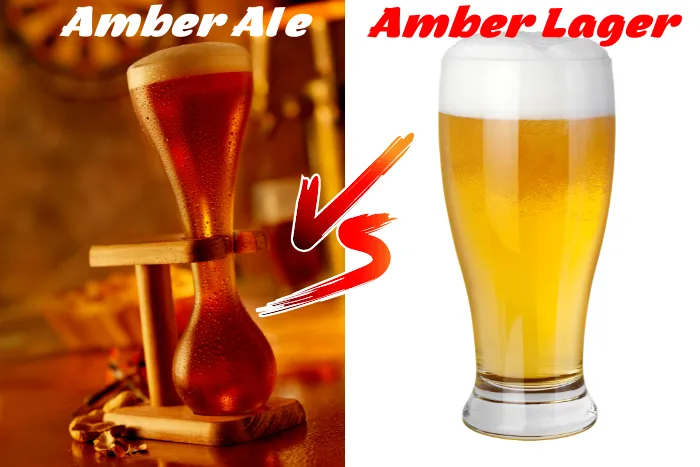What sets amber lager and ale beers apart from one another? What ingredients go into each beer type, how do fermentation and brewing processes differ, and what kind of flavor profile can you expect from both types of beers?
We’ll answer all these questions by exploring origins & history, health impact, alcohol content & IBU. Plus, to help you make an educated decision, we’ll select well-known labels for sampling. So if you’re wondering about the differences between amber lager and amber ale, read on.
Table of Contents:
- Origins and History of Amber Lager and Amber Ale
- Ingredients, Fermentation, and Brewing Processes for Amber Lager and Amber Ale
- Flavor Profile, Color, Alcohol Content, IBU, and Health Impact of Amber Lager and Amber Ale
- Popular Brands to Try for Each Beer Styles
- FAQs in Relation to Amber Lager vs Amber Ale
- Conclusion
Origins and History of Amber Lager and Amber Ale

Origin of Amber Lager
Bavaria is the birthplace of amber lager, which dates back to the 19th century. Amber lager is a brew with a malty taste and generally has a light body. The moniker “amber” is derived from the hue of the malt used to craft this beer variety. Amber lagers typically have an ABV (alcohol by volume) between 4-6%.
Origin of Amber Ale
The roots of amber ale can be traced to the UK in the early 1900s. This beer style has more hops than other ales and often has a darker hue due to caramelized malts or roasted grains used during brewing. Its flavor profile includes nuts, caramel, dark fruits, and spices. Amber ales typically have an ABV between 5-7%.
Their distinct flavors and aromas make them stand out from other beer styles, making them beloved worldwide. In addition, both beers are known for having lower bitterness levels than different styles, such as IPAs or stouts, making them more approachable for those who may enjoy hoppy beers less. Furthermore, they also tend to pair well with many different types of food, making them excellent options for meals or gatherings with friends and family alike.
Amber lager and amber ale have been around for centuries, each with its unique history. To gain insight into the production of amber lager and ale, let us examine the ingredients employed in their brewing and the fermentation process.
Ingredients, Fermentation, and Brewing Processes for Amber Lager and Amber Ale
Amber lager and amber ale are two popular beer types that share some similarities but also have distinct differences. Both beers employ a selection of malts to achieve their distinctive tastes, though the ingredients can differ depending on the brewer’s inclinations.
The fermentation process for both beers is similar, with yeast being added to convert sugars into alcohol. Conversely, the brewing processes and techniques employed to create each beer can differ significantly, leading to distinct flavor profiles.
Ingredients Used in Making Amber Lager
Brewers typically use pale malts and specialty grains such as Munich or Vienna malt for color and flavor for an amber lager. Other common ingredients include hops, water, and yeast. Depending on the beer style being brewed, other grains may be added for additional character or complexity, such as CaraMunich or Carafa Special III malts, which provide a roasted note to the finished product.
Ingredients Used in Making Amber Ale
Amber ale is usually made with pale malt and crystal malts like caramel 60L or 80L, which give it its characteristic reddish color and sweet malty flavors like biscuit or toastiness. If the brewer wants, they can also use dark crystal malts like chocolate rye or black patent malt to add dark malty flavors like chocolate or toast. Hops are usually added for bitterness balance, while other adjuncts may be included depending on what flavor profile the brewer selects, including spices like coriander seed or orange peel.
Amber Lager and Amber Ale: Fermentation and Brewing
The components will be located, prepared following the directions, and then placed in a fermenter with yeast to begin fermentation. Over several days, it will break down sugars into alcohol until reaching desired gravity readings, after which further processing may occur before bottling/kegging/canning, etc.
The brewing process begins with mashing, where hot water is mixed with the crushed grain (usually pale) inside a mash tun to create “wort.” This wort is then boiled alongside hops before quickly cooling down so that yeast can be pitched into it.
It results in fermentation over several days until ideal gravity readings have been achieved. After this point, further processing may occur if needed before packaging takes place via bottling, kegging, or canning.
The ingredients, fermentation, and brewing processes for amber lager and ale are similar but have subtle differences that make each beer unique. Next, we will explore the flavor profile, color, alcohol content, IBU, and health impact of both beers to help differentiate between them.
Flavor Profile, Color, Alcohol Content, IBU, and Health Impact of Amber Lager and Amber Ale

Both brews offer a particular flavor, hue, ABV (alcohol by volume), IBU (International Bitterness Unit), and health effects to assist in selecting the right one for your palate.
Amber Lager vs Amber Ale: Flavor Profile
Amber lagers tend to be malty with a slight caramel flavor, while amber ales are usually hoppy with hints of dark fruit flavors like raisins or plums. The maltiness of an amber lager comes from its use of light-colored malts such as pilsner malt, while an amber ale typically uses darker-colored malts like crystal or Munich malt.
Amber Lager vs Amber Ale: Color
Amber lagers have a light golden hue, whereas amber ales range from deep copper to reddish brown. This color difference is due to the type and amount of roasted grains used during brewing; lighter-colored grains create a lighter beer, while darker grains create deeper hues.
Amber Lager vs Amber Ale: Alcohol Content, IBU, and Nutritional Value
Generally speaking, both types contain similar levels of alcohol ranging from 4% to 6%. However, some craft breweries produce high-alcohol versions that can reach up to 8%.
International Bitterness Unit (IBU) for Both Beers
IBU measures how bitter a beer tastes on a scale between 0 – 100+ IBUs; higher numbers indicate more bitterness than lower ones. An amber ale typically exhibits slightly higher anger than an amber lager, with IBU levels ranging from 30 to 35 compared to 20 to 25.
Health Effects of Both Beers
Like all alcoholic beverages, drinking too much can lead to adverse health effects such as liver damage or addiction, so moderation should always be practiced when consuming either type, regardless of its calorie count.
Regarding nutritional value, both beers offer B vitamins and minerals like magnesium and potassium. Still, since they’re made using different ingredients, their overall dietary content varies greatly depending on the brand chosen.
Popular Brands for Each Beer
When it comes to amber-hued brews, a wide selection of popular labels are available for tasting. Craft breweries have something for everyone, from light beers like Dos Equis Amber to dark lagers like Vienna Lager.
Popular Brands for Amber Lager
Amber lagers tend to be made with caramel malts and colored malt, giving them a deep amber color and a malty sweetness. It possess a mild alcoholic potency (5-6%), making them an ideal choice for those who don’t desire too much of a boozy kick.
Popular brands include
- Warsteiner Premium Verum
- Köstritzer Schwarzbier Dark Lager
- Spaten Oktoberfestbier Ur-Märzn
- Augustiner Edelstoff Helles Lagerbier
- Hofbräu München Original Lager Beer
Popular Brands for Amber Ales
Amber ales are usually darker due to the utilization of English pale ale or brown ale yeast in their brewing process, and typically have a higher alcohol content (4-7%) than lagers. The alcohol content is also higher (4-7%), so they offer more of a punch than your typical beer.
Popular brands include
- Sierra Nevada Pale Ale
- Anchor Liberty Ale IPA
- Red Hook ESB Extra Special Bitter Ale
- Fuller’s London Pride British Style Pale Ale
- Goose Island Honker’s Ale
- American Bitter Style Ale
No matter your taste, you can find a wide range of delicious brews from craft breweries globally to appease any beer lover.
FAQs in Relation to Amber Lager vs Amber Ale
What is the difference between Amber lager and Amber Ale?
Amber lager and ale differ in their ingredients and brewing processes. Amber lager uses bottom-fermenting yeast strains that produce less fruity flavors and more hops to give it a slightly bitter taste. More balls make them bitter.
Amber ales are sweeter due to higher malt sugars and fruitier top-fermenting yeasts. Lagers age longer at colder temperatures, while ales are fermented faster at warmer temperatures.
Is Amber ale the same as Amber beer?
No, amber ale and amber beer are not the same. Due to its malt content, amber ale is a type of beer with an orange to a reddish hue. It usually has a medium body with notes of caramel and toastiness in flavor.
On the other hand, amber beer is simply any style that falls within the color range between yellow and brown on the SRM (Standard Reference Method) scale. While some beers may share similar characteristics, such as their color or taste, they cannot be classified as one another unless specified by name or style.
What is the difference between ale and amber?
Ale and amber are both types of beer, but they have distinct differences. Ale is a brew made with top-fermenting yeast that ferments at higher temperatures than other yeasts, producing flavors ranging from fruity to spicy and colors varying from light to dark.
Ales typically have a fruity or spicy flavor profile and can go in color from morning to night. Amber beers are ales that use specialty malts to create their unique color, usually from golden orange to reddish brown. Ales with caramelized malts added in the brewing process are often more balanced and malt-forward than those without.
What makes an amber lager?
An amber lager is a beer with an amber to copper color and a malt-forward flavor. It typically has low hop bitterness but may have some hop aroma. Amber lagers are usually medium-bodied with a smooth mouthfeel, moderate carbonation levels, and a good balance between malt sweetness and hop bitterness. The alcohol content can range from 4% ABV up to 8%. They often pair well with food due to their malty character.
Conclusion
In conclusion, amber lager and amber ale are two distinct beer types with different origins, ingredients, fermentation processes, flavor profiles, colors, alcohol content levels, and IBU. While both offer a unique experience for the craft beer enthusiast to enjoy in moderation with friends or family, there is yet to be a definitive answer as to which one is better. Ultimately it comes down to personal preference when choosing between an amber lager vs. an amber ale. With this information, you should now be able to decide between amber lager and ale.
Also See: Exploring the Differences Between IPA and Imperial IPA

